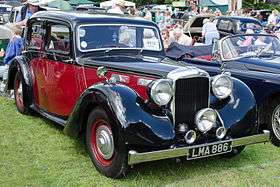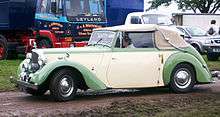Alvis TA 14
| Alvis Fourteen TA 14 | |
|---|---|
 Fourteen sports saloon 1949 | |
| Overview | |
| Manufacturer | Alvis Cars |
| Production |
1946–1950 3311 produced[1] |
| Body and chassis | |
| Body style | |
| Layout | FR layout |
| Powertrain | |
| Engine | Alvis 1892 cc Straight-4[2] |
| Transmission |
|
| Dimensions | |
| Wheelbase |
|
| Length | 174.5 in (4,432 mm)[3] |
| Width | 66 in (1,676 mm)[2] |
| Height | 61 in (1,549 mm) saloon[2] |
| Kerb weight | Saloon 28 cwt, 3,136 lb (1,422 kg)[2] |
| Chronology | |
| Predecessor | Alvis Twelve or 12/70[2] |
| Successor | Alvis Three Litre or TA21 |
| Alvis 14 | |
|---|---|
| Overview | |
| Manufacturer | Alvis |
| Combustion chamber | |
| Configuration | Straight 4-cylinders[2] |
| Displacement | 1,892 cc (115.5 cu in)[2] |
| Cylinder bore | 74 mm (2.91 in)[2] |
| Piston stroke | 110 mm (4.33 in)[2] |
| Cylinder block alloy | cast iron monobloc with cast aluminium crankcase. the 3-bearing crankshaft is both statically and dynamically balanced[2] |
| Valvetrain | overhead, tappets pushrods and rockers, single camshaft driven by triplex chain. inlet 35 mm slightly larger than exhaust valves 32 mm.[2] |
| Compression ratio | 6.9:1[2] |
| Combustion | |
| Fuel system | siamesed inlet ports, cast aluminium manifold, single horizontal 38 mm S.U. Electric pump by S.U. from petrol tank[2] |
| Management | Lucas 12-volt[2] |
| Fuel type | low octane Pool petrol[2] |
| Cooling system | water, pump and fan |
| Output | |
| Power output |
|
| Chronology | |
| Predecessor | Alvis 12/70 |
| Successor | none |
The Alvis Fourteen also known as TA 14 was the first car to be produced by major defence contractor Alvis cars after World War II. The entire car factory had been destroyed on the night of Thursday 14 November 1940.[4] Announced in November 1946 it was made until 1950 when its postwar austerity 1900 cc engine was replaced by the 2993 cc 26.25 HP (tax rating) Alvis Three Litre or TA 21.
First postwar Alvis
The Fourteen was available as a four-door sports saloon built for Alvis by Mulliners of Birmingham but there were also Tickford and Carbodies drophead versions. When compared with the 12/70 car it replaced the interior is 4 inches wider and the distance between rear-seat armrests is increased almost 5 inches.[5]
Engine
The 1892 cc engine is a slightly larger-bore version of the one used in the 12/70 and produced 65 bhp (48 kW).[3] It is fitted with a single SU type H4 -inch side-draught carburettor. Inlet valves have been enlarged. The triplex chain drive has been given an automatic tensioner. The engine's exhaust system has been extensively revised and the direction of flow of cooling water around the engine has been substantially changed.[5]
Brakes suspension steering
The bodies were mounted on an updated pre-war Alvis 12/70 chassis that was widened and lengthened but retained the rigid-axle leaf spring suspension. Employing Silentbloc bushes (except at the front of the front springs to maintain steering precision) it is controlled by double acting Armstrong hydraulic dampers. Hypoid bevel final drive was fitted for the first time and greatly reduced the height of the transmission tunnel. Steering is by Marles with a spring spoked steering wheel. Mechanically operated brakes are two-leading-shoe type by Girling. Disc wheels replaced the 12/70's wire wheels and are fitted with larger tyres.[5]
The top speed is around 74 mph (119 km/h) and acceleration from 0 to 60 mph (97 km/h) in 22.2 seconds.[1]
-

Standard sports saloon
-

Standard sports saloon
-

Sports saloon
by Raine of Durham
-

drophead coupé
by Tickford -

drophead coupé
by Carbodies -

drophead coupé cabriolet
by Mead
-
.jpg)
fixed head coupé by Duncan Industries 1947
-

Road test
Autocar reported the new car had the typical Alvis refined sure-footed and lively performance. Its synchromesh "worked like a charm".[5] The Motor said the car was much roomier than the compact close-coupled exterior suggested, rear seat knee-room was between 8 and 13 inches. A most impressive car with a flexible 4-cylinder engine. Wind noise was noticeable at high speed.[2]
References
- 1 2 Robson, Graham (2006). A-Z British Cars 1945–1980. Devon, UK: Herridge & Sons. ISBN 0-9541063-9-3.
- 1 2 3 4 5 6 7 8 9 10 11 12 13 14 15 16 17 18 19 The Post-war Alvis Fourteen, The Motor magazine 13 November 1946, Temple Press, London
- 1 2 Culshaw; Horrobin (1974). Complete Catalogue of British Cars. London: Macmillan. ISBN 0-333-16689-2.
- ↑ Frederick Taylor, Coventry: Thursday, 14 November 1940, Bloomsbury, 2015 ISBN 9781408860267
- 1 2 3 4 An Admirable Alvis, Autocar Magazine 15 November 1946, London
Further reading
- Clarke, RM (1989). Alvis gold portfolio 1919–1967. Cobham, Surrey, England: Brooklands Books. ISBN 978-1-870642-84-2.
- Culshaw, D (2003). Alvis three litre in detail: TA21 to TF21 1950-67. Beaworthy, Devon, England: Herridge and Sons Ltd. ISBN 978-0-9541063-2-4.
External links
| Wikimedia Commons has media related to Alvis TA 14. |